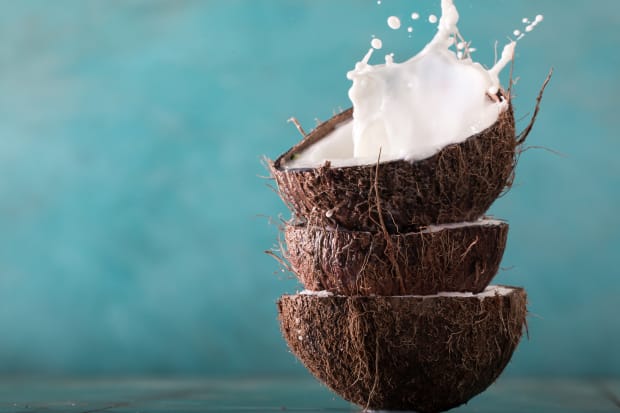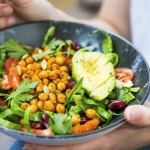- Like
- SHARE
- Digg
- Del
- Tumblr
- VKontakte
- Flattr
- Buffer
- Love This
- Save
- Odnoklassniki
- Meneame
- Blogger
- Amazon
- Yahoo Mail
- Gmail
- AOL
- Newsvine
- HackerNews
- Evernote
- MySpace
- Mail.ru
- Viadeo
- Line
- Comments
- Yummly
- SMS
- Viber
- Telegram
- JOIN
- Skype
- Facebook Messenger
- Kakao
- LiveJournal
- Yammer
- Edgar
- Fintel
- Mix
- Instapaper
- Copy Link
When you hear “potassium,” you probably think about bananas. But the truth is, there are many better sources of this important electrolyte. Studies link adequate potassium levels with reduced risk of high blood pressure, heart disease, osteoporosis, diabetes, Alzheimer’s, and stroke. And it’s especially important during summer, when heat, exercise, and sweating can significantly deplete potassium levels, leading to weakness, fatigue, muscle cramps, heart palpitations, and mood changes.
The recommended daily intake for potassium is 4,700 mg, but most people get only a fraction of that amount. While bananas have decent amounts—400 mg, or about 9 percent of the daily value (DV) in a medium banana—they’re not the best source (and you can only eat so many bananas). Instead, try these seven summer-centric, high-potassium foods, each with more than 15 percent of your daily needs.
1. Watermelon
This hydrating summer fruit has 640 mg of potassium in two wedges, or 18 percent of the DV. Honeydew, cantaloupe, and other melons are also loaded with potassium. Watermelon is also an excellent source of the antioxidant lycopene.
Recipe Tips: Purée watermelon with lime juice and mint for an alcohol-free mojito; toss watermelon balls with blueberries, cucumber, and minced basil; make a fresh, fruity salsa with diced watermelon, minced red onion, jalapeño pepper, pineapple, and lime juice.
2. Coconut water
This light, refreshing and hydrating beverage is loaded with potassium—600 mg, or 17 percent of the DV, per cup. And because it’s a balanced source of other electrolytes, including magnesium, calcium, and sodium, coconut water is an excellent low-calorie choice for summer hydration.
Recipe Tips: Purée coconut water with raspberries until smooth, stir in whole blackberries, and freeze in Popsicle molds; combine coconut water, lemon juice, and honey or agave for a refreshing lemonade; purée coconut water with shredded coconut and mango cubes, and freeze in an ice cream maker.
3. Mushrooms
A cup of cooked brown (cremini) mushrooms has 555 mg of potassium, or 15 percent of the DV. Plus, they’re the only plant source of naturally occurring vitamin D. Some varieties, like shiitakes, are also rich in compounds that support immune health.
Recipe Tips: Toss sliced mushrooms with olive oil and minced rosemary, arrange on a grill basket, and grill until tender; sauté shiitake mushrooms, green onions, bok choy, carrots, and ginger in sesame oil, then toss with tamari and cooked soba noodles; sauté wild mushrooms, fennel, and leeks, and serve on polenta.
4. Potatoes
One cup of boiled new potatoes contains almost 600 mg of potassium, or 16 percent of the DV. Other potatoes, including sweet potatoes, have similar amounts. Plus, sweet potatoes and purple potatoes are especially high in antioxidants.
Recipe Tips: Toss cooked and quartered new potatoes with minced red onion, diced celery, and basil with a lemon-yogurt dressing for a healthier take on potato salad; thinly slice sweet potatoes, brush with olive oil and grill until tender; sauté diced blue potatoes with black beans, corn, red peppers, and onion, and garnish with avocado cubes, cilantro, and pumpkin seeds.
5. Spinach
It’s packed with potassium: one cup of cooked spinach has 839 mg, about 24 percent of the DV. Spinach is also rich in beta-carotene and other nutrients, and it’s one of the best sources of the antioxidants lutein and zeaxanthin.
Recipe Tips: Make a tropical green smoothie with spinach, pineapple, and coconut milk; toss shredded spinach with cubed golden beets, black lentils, walnuts, and feta cheese; purée spinach, avocado, basil, and olive oil until creamy, then toss with cooked spaghetti squash.
6. Lima beans
Also called butter beans, these small, tender legumes are loaded with potassium—one cup cooked has 969 mg, about 18 percent of the DV. Plus, they’re loaded with protein and fiber. Other beans, peas, and lentils have similar amounts.
Recipe Tips: Make succotash with lima beans, corn kernels, diced zucchini, onions, and red peppers; cook lima beans, potatoes, onions, garlic, and thyme in broth, then purée for a creamy soup; sauté cooked lima beans with shredded kale, diced carrots, and leeks, and top with ricotta salata cheese.
7. Chard.
Like most greens, chard is loaded with potassium. One cup cooked has 961 mg, about 27 percent of the DV. It’s also high in beta-carotene, and varieties with red and yellow stems are rich in lutein and other antioxidants.
Recipe Tips: Lightly steam whole chard leaves and wrap around a filling of quinoa, red lentils, garlic, and cumin; thinly slice red chard and sauté with leeks and wild mushrooms; toss shredded chard leaves with cherry tomatoes, chickpeas, black olives, and feta cheese, and dress with olive oil.
Click here for Cantaloupe-Basil Sorbet recipe, which is packed with potassium.


